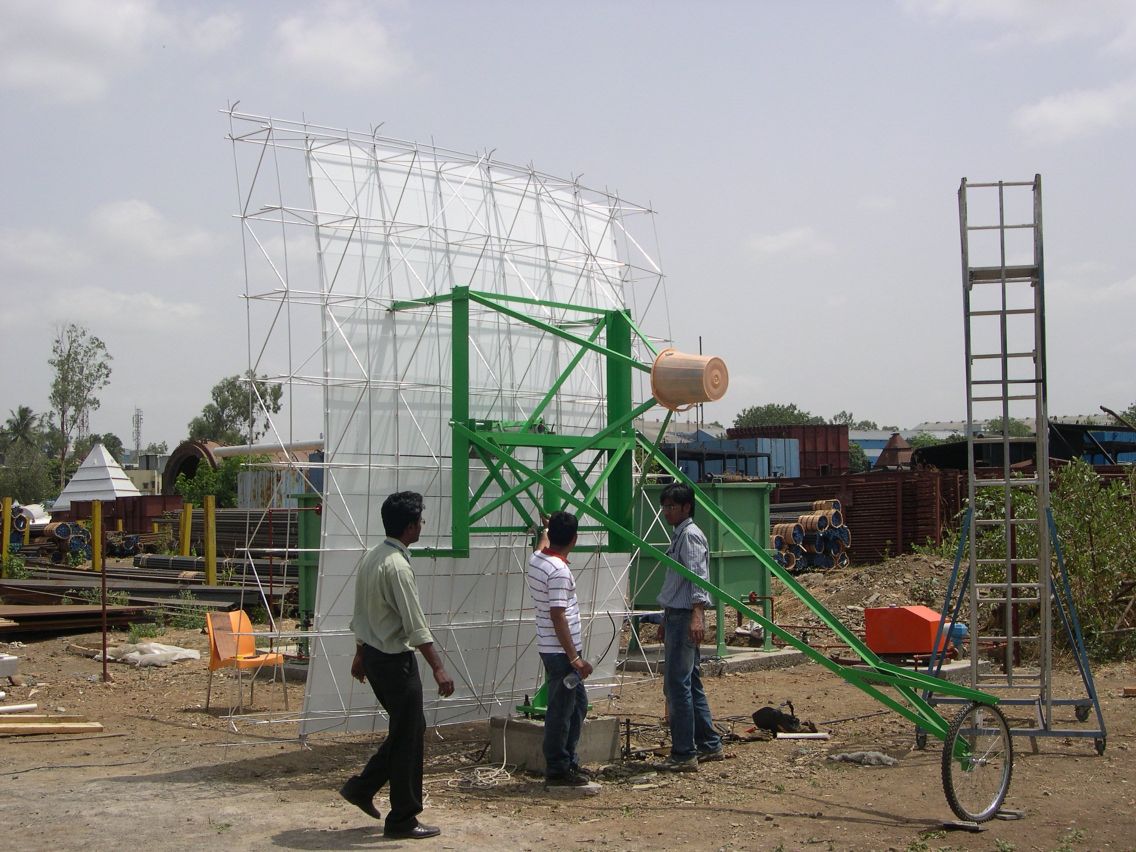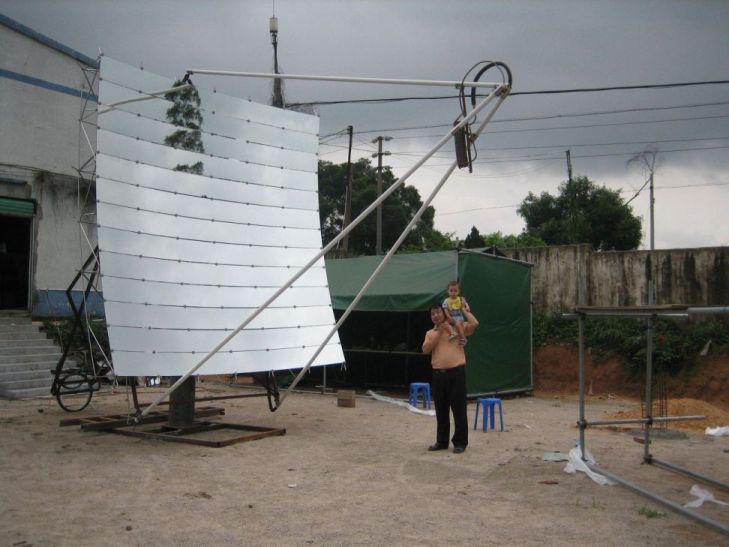
Solar Steam by sunflower
Pitch
MIT solutions to global warming will bring affordable clean energy to billions of people, especially in the developing world.
Description
Summary

Solar is by far the largest energy source on earth, much larger than all fossil fuel reserves combined. One square meter of sunlight in Colorado climate is worth 2000 kWh per year. One m^2/year (the size of a folding card table) is worth more than one barrel of oil per year.
Solar glass mirrors are 96% efficient and cost $25/m^2 at scale. All glass solar concentrators cost about the same. Solar dishes are the most efficient at 91% or 80% with average dirt in the real world. Solar dishes can melt steel. Research indicates solar dish cost at about $100/m^2, less than $0.20/Watt. These numbers demonstrate solar energy cheaper than all types of fossil fuels.
Fast global scale up requires technology transfer for local autonomous integration, like building houses in India with local materials and local labor. New manufacturing is not needed for massive parallel construction using existing commodities and existing labor skills.
Solar steam can be used for district heating. With seasonal heat storage city-wide heat and hot water can be supplied all day the whole year. Whole cities can be 100% solar heated from solar collectors located 30 miles away. http://www.dlsc.ca/borehole.htm
Other applications include absorption chilling air conditioning, industrial process heat, cooking food, water purification, and 35% of the energy can be power created with solid state generators (type III-V HIPV ~ high-intensity photovoltaic cells).
Solar concentrators are like airplanes and cars. They will evolve. It is a multi-trillion dollar global market.
MIT and alumni can research, develop, and disperse new solar steam technologies for district heating, district chilling, and industrial process heat.
--Doug Wood
--Sunflower 501(c)(3) nonprofit
-- fox@harbornet.com
What actions do you propose?
Create MIT graduate engineering group to take possession of solar technology and carry it forward into the future.
The goal is industrial solar development, testing, and global dispersal.
Primary applications -- District heating, district chilling, solar industrial process heat, and total energy systems.
What is the cost of solar energy displacing carbon emissions? That is the guiding question of our research.
What is the cost of solar collectors at scale, like that of a billion cars and a billion buildings?
What is the best performance of solar collectors?
Our literature search showed that solar concentrators have top performance. High energy concentration yields small black body radiation and dual axis tracking yields zero cosine losses. Parabolic dishes are the best for collecting energy from distant radiant sources. Dish performance is easy to predict and easy to measure. Predicting cost of mature high volume dish production is not easy.
Production cost parameters include design, tooling, materials, transportation, labor, applications, land, balance of system, maintenance, durability, cost of capital, and so on. Proving hardware cost requires massive deployments of mature technology. Our approach to predicting cost was to zero-out as many variables as possible, such as using existing commodities and existing labor skills, no new tooling, low cost applications on low cost land, high durability with low maintenance, low risk capital. Design engineering is the most difficult cost variable.
Complexity is easy. Simplicity requires time, effort, and creativity. Economic breakthroughs are not-seen materials removed from design.
http://www.harbornet.com/sunflower/solar_dish.html
DESIGN HISTORY --
Size matters. What is the cost-optimum size? Conventional wisdom was economy of scale, larger sizes cost less per square meter of aperture. Each size sample must be fully engineered then compared, constructed, and tested. We prototyped a 30 foot diameter dish followed by a 40 foot diameter dish. The latter was tested at 91% efficient direct sun to hot water. Patents were allowed for geodesic paraboloids. The design process was structural engineering intensive using wind tunnel data. The main dish components were low-iron glass mirror, mirror substrates, aluminum super structures, steel support carriages, concrete foundations, tracking drives, electronics, high pressure receivers, and steam pipes.
30 foot diameter
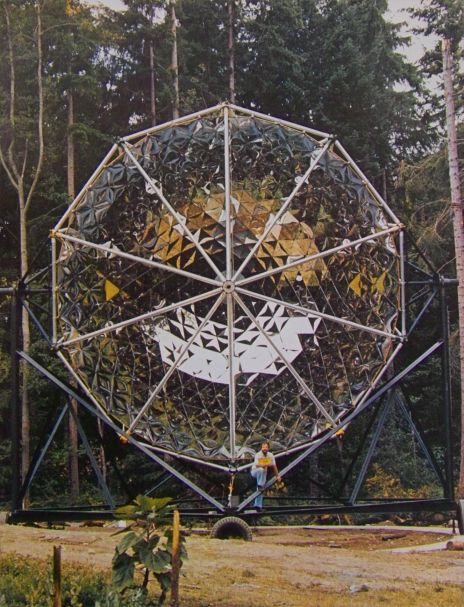
40 foot diameter
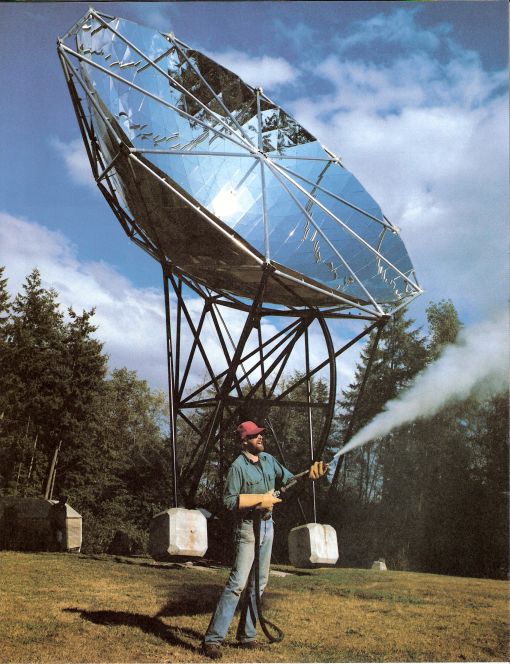
Glass substrates were made from sheet aluminum stretched formed into compound curves like the nose of a commercial jet plane. We worked with Boeing engineering examining hammer presses using male/female graphite dies, very expensive tooling. Hammer press stretch forming has a five foot size limit due to the friction across the die blank. We then created the radical innovation of clamping sheet metal across the female die and dropping the assembly into very deep water at Crater Lake. A million pounds of force stretched the metal into the die. The hammer press and die size limits were eliminated. Later applications of this new idea were tested at a deep water submarine research facility off Fox Island in Puget Sound.
In another area of research, there were many, we explored using dimensionally large fluid optical wave guides to transport high-intensity sunlight from the focus of a mirrored 3 meter satellite dish to loads in a building. The applications included lighting, heating, and high-intensity photovoltaic cells (type III-V). Results showed high attenuation losses and high costs so the effort was abandoned. AB Lovins then asked about small dish cost and we found that cost per aperture area of the small dish was three times less than our "low-cost" big dishes. We were very surprised and disappointed. The big dish plans had to be abandoned after all that work, time, and money. Small dishes were so much better. It was a breakthrough in solar economics.

In addition to size, the small dish showed another breakthrough. The flat glass mirror slats were flexed into a curve with tension screws at edge mid points. The curve was a perfect parabola with excellent optics. Only the corners of the mirrors touched the substrate. This eliminated the need for glass mirror substrates. Hydroforming sheet metal into stretch-formed compound curves was abandoned, a significant cost reduction in materials and tooling. A patent claim was allowed for the invention of flat mirror curvature without substrates. http://www.harbornet.com/sunflower/patent.doc
The small round dish was redesigned as square dish to leverage flexing long mirror slats. Slicing a paraboloid with any planes parallel to the axis makes all identical curves for all layouts. Only paraboloids have this property. The method of building a paraboloid space-frame from all identical parts was allowed a patent claim. This simple design innovation enabled significant cost reduction in labor and tooling.

We created new materials properties from the crystalline modification of spinel during calcination. This innovation has wide applications in the marine, irrigation, and solar industries. We could assign IP to MIT in exchange for engineering support.
In an effort to solve the problem of spiders crawling on shadow band sensors we discovered a new hyper accurate solar tracking technology. A shadow band sensor is typically a 10 cm wall separating two photo transistors. As the moving sun makes a shadow on one side sensor the solar tracker moves to balance the light. When placing a small glass sphere above a thin sheet metal wall with the sphere focus at the top edge of the wall then the 10 cm wall appears 3 meters high. This makes the shadow band super accurate at ± 0.005 degrees, important for uniform flux on high-intensity photovoltaic cells, HIPV type III-V. Each eye has two photo transistors, a thin sheet metal wall, a 30mm glass ball, housed in a 1 inch by 3 inch long PVC pipe, all parts at a total retail cost less than $5.

The flux of a dish can melt rocks. Ground torching can be a fire hazard. So we built a micro to mitigate this danger. It is important that the dish track the sun accurately in sunshine or approximately through clouds. The dish stows up if there is a tracking problem or high winds. The software reads time & date, dish position via accelerometers, motor functions, wind speed, and shadow band sensors. The PIC also reads from memory the previous sunny day solar position, measures movement if a motor is on, resets the clock to solar noon when sun pointing due south, calculates solar position anywhere on earth, then takes the appropriate actions. The dish is a dangerous autonomous robot within a 4m radius. Turning the power off and on will stow a field of dishes for safety. Turning the power off, waiting 10 or more seconds, then turning the power on resumes tracking. http://www.harbornet.com/sunflower/PCB.pbp
FOX ISLAND
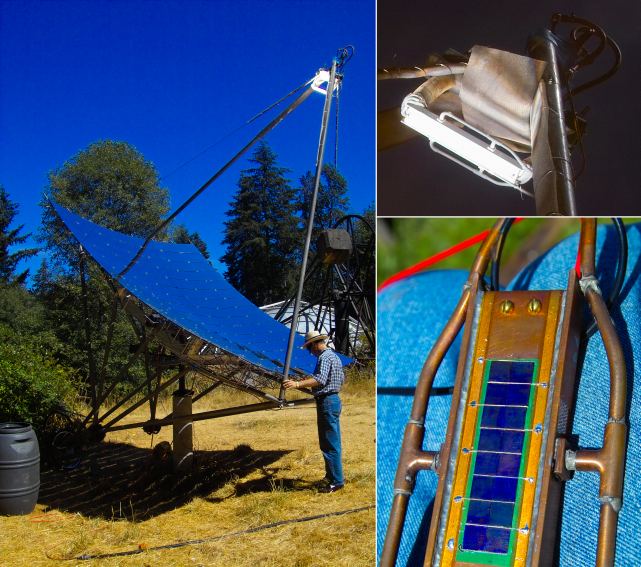
We tested reproducibility without special manufacturing, just email to MIT & Cleveland State (scholastic research), India & China (industrial process heat). Construction used locally available commodities and existing labor skills. This is key for massive parallel production at rapid scale up. Local integration enables low cost transport and labor. Maintenance is accessible with local production. Capital is preserved by using soft currency, such as rupees, competing with hard currency, such as US dollars, for imported fossil fuels.
The dish was 12 by 12 foot square with 12 foot mirrors. Twelve foot glass ribbon width is only available in North America which caused problems for India and China. So the dish was redesigned approximately 16 by 16 foot square with two rows of 7 foot glass mirrors. India then constructed a second dish. India boiler codes will not allow copper tubing so a steel receiver was developed. The micro software was upgraded for equatorial solar tracking.
South Africa improved micro design for printed circuit boards and upgraded the software for solar tracking in the southern hemisphere. http://www.harbornet.com/sunflower/PCB.jpg
A term sheet for $5.5mn was signed by a Boston area venture capital firm for an MIT solar dish start-up company, RawSolar, but the term sheet was not honored due to the 2008 market crash. RawSolar defaulted on engineering costs at Forell Structural Engineers, San Fransisco, and was disbanded.
FUTURE WORK --
The new dish design is larger and needs structural engineering for foundation, steel, and aluminum under various load conditions. The results of this engineering will be the most significant driver of cost and most important for reliability.
A new receiver made from titanium should be examined. Miles of thin wall small diameter titanium tubing are used in the cooling towers of power plants. This tubing could be coiled for dish receivers. Attributes include high temperature applications, stagnation protection, corrosion resistance, long life, low maintenance, low electrolysis, and low thermal inertia. NREL could help with the black surface, perhaps just Pyromark black paint. Selective surface black coatings are not needed.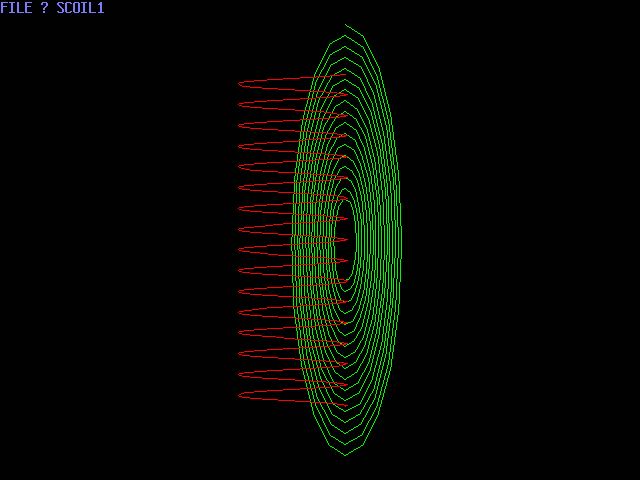
Mirror stack research is needed for enhanced durability. We had an unique experience at MIT. The mirrors delaminated the first winter. The cause is unknown. It could be the novel replacement of copper with palladium by Guardian, not a good idea. Or it could be the wicked winter weather in Boston. An ice storm may have adhered ice to the mirror backs then chilled to subzero temperatures and the thermal coefficient of expansion difference between glass and ice pulled the silver from the glass. Tests are needed in this area. Teflon-like paint may be a solution. https://www.technologyreview.com/s/421690/surfaces-that-keep-the-ice-away/ Another area of concern is ultraviolet degradation of paint binders. Adding pigment Color Index 36 (blue-green) will totally protect paint from UV. Since the OPEC oil embargo NREL has conducted decades of glass mirror durability research and can help with mirror stack ideas. PPG is a paint and solar mirror manufacturer. I would recommend their 2mm by 7 foot low-iron glass mirror. BrightSource may share mirror technology, maybe even supply a sample heliostat. We tried to make heliostat and trough technology work. Dishes are fundamentally better.
Micro-controller printed circuit boards are needed for a dozen beta test dishes. Printed circuit boards for solar dish tracking is the one area of technology transfer that requires the most hand holding. This is a vertically integrated item and could be the main source of revenue. The other sources of revenue could be consulting engineering and technology licensing. The main objective is global carbon emission mitigation. Revenue is only for engineering sustainability. ![]()
Global technology transfer for rapid expansion of local production is the main goal.
We are seriously out of time, must move forward with reckless speed and learn by doing. Build, engineer, build, engineer, transfer, repeat.
It is important.
Clean energy technologies need space, support, people.
Balance of system requirements are highly diverse in terms of application temperatures, footprint of demand, value, cost, and performance. Least cost is hot water and wet steam plugged into existing systems. Typical field piping to headers would be ordinary insulated half inch water piping of trivial cost. Pipe performance nominally 95% at 105 C.
Small industries closed on weekends would benefit from two day storage tanks. Large industries can use annual bore-hole ground storage to match 100% loads. Seasonal heat storage cost depends on ground type, rock most expensive and clay least expensive, typically 30% of system cost. Annual storage performance can be 90% in very large systems.
NREL Solar Radiation link -- http://rredc.nrel.gov/solar/old_data/nsrdb/1961-1990/redbook/atlas/
-- Expanded addenda at the end of this tab below References.--
Who will take these actions?
MIT Sloan School of Management, Graduate students & alumni, Sunflower, and the National Renewable Energy Laboratory (NREL).
Sunflower will assign patents and IP to MIT.
Engineering is needed in materials, structural/civil, robotics/mechatronics, mechanical/thermal, and production.
Open solar concentrator design collaboration will seek low raw materials content, simplicity, durability, efficiency, efficacy, economics, and indigenous production. There are no limits on group size and participation creating solutions.
Where will these actions be taken?
MIT Cambridge
How much will emissions be reduced or sequestered vs. business as usual levels?
Blue sky unknown.
Cost target $100/m^2 (global average) + 3% O&M/year.
At 1400 kWh(t) / m^2 / year --
Worth 42 mWh(t) / m^2 / 30 years.
Displace 7.5 metric tons CO2 (displacing methane gas) / m^2 / 30 years.
If minimum 20 million m^2 deployed then CO2 displacement would be 5 million metric tons per year.
Goal is 20 billion m^2 globally within 40 years via tech transfer. CO2 displacement 14% of global BAU.
$13.33/metric ton CO2 @ 0% discount.
What are other key benefits?
Local energy in both developing and developed economies, jobs, security.
Hard currency is used for imported carbon fuels. Soft currency is used for domestic production of clean energy.
What are the proposal’s costs?
Total $5mn 5 years
5 years --
5 engineers $2mn
Workspace $0.5mn
Materials and tools $0.5mn
Travel & overhead $2mn
Time line
Fast global scale up requires technology transfer for local autonomous integration. New manufacturing is not needed for massive parallel construction using existing commodities and existing labor skills.
Rate and scale of dispersal is unknown, could be fast and huge.
In months --
9 - Preproduction prototype.
3 - Performance testing + engineering.
4 - Production prototype.
2 - Performance testing + engineering.
18 - Production methods and beta deployments.
36-60 - Global technology transfer.
Related proposals
References
http://www.youtube.com/watch?v=t9rc3fDuxE4
http://mitei.mit.edu/news/mit-prototype-solar-dish-passes-first-tests
http://www.youtube.com/watch?v=Y366lZE32eg
Home http://www.harbornet.com/sunflower/pvdish.html
Amory Lovins ablovins@rmi.org
Addenda 2016.06.08
Technology design, distribution, and applications are grounded in extensive market research.
Most of the IPH systems tested were closed-loop deaerated water plumbed with conventional steam pipes and heat exchangers connected to the inputs of existing boilers. The boilers then controlled temperatures and flow rates to loads. This is also done in India. 
District heating is a sustainable energy delivery system. Sweden recently connected nearly all buildings to a new polymer heating grid, then interconnected whole cities together and deployed borehole seasonal heat storage. They found it simple to connect large solar arrays to the return heat pipes. Such systems are new to North America. This is a link to a system in Northern Alberta. http://www.dlsc.ca/index.htm
Stanford, for example, wanted six dishes hooked to a dorm for evaluation then thousands of dishes on their land connected to their district heating grid. They are currently buying low carbon electricity from the utility for low temperature heat. Universities will be very aggressive early adopters of solar steam for district heating and cooling.
Concentrator photovoltaic cells (CPV) and high-intensity photovoltaic cells (HIPV) type III-V are a cool way to make low-cost efficient power. Cooling is key. See video -- https://www.youtube.com/watch?v=xmF9fLvCEDw
CLIMATE - Cloud cover is much more important than latitude. Without clouds everybody would get about the same energy per year. Seattle gets about half the direct sun of Phoenix which requires twice the aperture area for similar performance, same as moving Seattle to Phoenix. NREL has an excellent tool for making climate performance calculations. http://rredc.nrel.gov/solar/old_data/nsrdb/1961-1990/redbook/atlas/ http://harbornet.com/sunflower/130.gif
http://harbornet.com/sunflower/130.gif
LAND - Packing density for dual axis tracking is about 25% to avoid shading from low altitude sun, like the spacing of fruit trees in a field. There are about 4000 m^2 per acre allowing 1000 m^2 concentrator aperture per acre, about $100,000 to $200,000 hardware per acre. Undeveloped barren land and brown fields could be 5% to 10% of system cost.
Our business plan to supply open source solar steam technology comes directly from our market research. It is the only way to scale quickly at low cost. The plan is to build sample concentrators then publish engineered blueprints online. Consulting engineers would be available to assist international technology transfers, likely involving a lot of global travel and tech improvements.
Solar concentrators can supply humanity with nearly all required energy sustainably -- heating, cooling, power, and transportation.
Impact vision must see video. https://www.youtube.com/watch?v=nr-grdspEWQ
